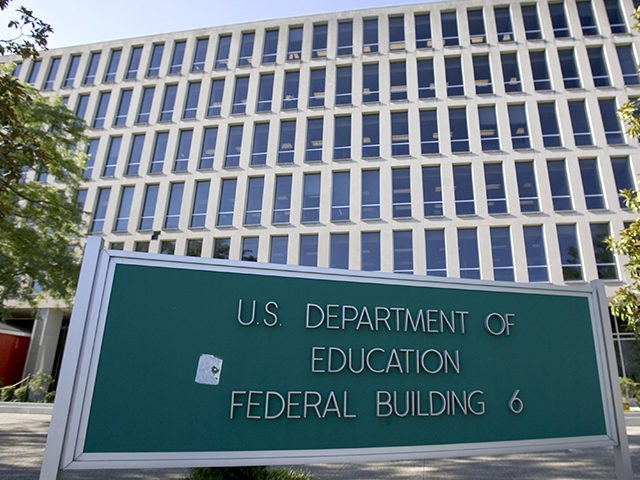Closing down the U.S. Education Department (USED) could be a snap compared to repealing and replacing Obamacare.
A bill, House Resolution 899, filed by Rep. Thomas Massie (R-KY) and seven co-sponsors on the day Betsy DeVos was confirmed as education secretary would start the beginning of USED’s deconstruction with just one wonderfully succinct sentence: “The Department of Education shall terminate on December 31, 2018.” That is the entirety of the bill. The contrast with hard-to-fathom legislation running hundreds or even thousands of pages is refreshing. And the sunset for an agency that has generated more red tape than positive results over its nearly four-decade run would be absolutely gorgeous.
USED is a monument to the failure of the strategy to use centralized education policymaking to boost learning. Furthermore, its ventures into shaping and tracking student feelings, attitudes, beliefs, and dispositions have become steadily more of a threat to individual liberty.
President Donald Trump has in the past signaled his possible support for shuttering USED, but Trump’s initial budgetary blueprint funds the department at $59 billion for fiscal year 2018. His budget would eliminate several unproductive programs, such as the so-called 21st Century Learning Centers, at a total savings of $9 billion (a “cut” of 13 percent for USED). Trump’s plan would continue to protect funding for disabled students, historically black colleges, and other causes.
The education establishment’s trumpet, Education Week, wrote of the “historic” Trump commitment to school choice, implying it basically supplants such supposedly popular programs as subsidized after-school activities. However, the bulk of the $1.4 billion earmarked for choice would enable some low-income parents to transfer their kids to other public schools—not exactly a robust choice. A $168 million increase in federal start-up money for charter schools would raise the danger of increased federal regulation of charters while possibly further impinging on the ability of Catholic schools to compete in the education marketplace. Only the proposed $250 million federal scholarship program for private choice is potentially ground-breaking; however, such an approach carries the danger of federal agendas intruding in voucher-recipient private or homeschools.
Given the likelihood of USED continuing to devour tax dollars with precious little bang for the buck, Massie’s idea of a deadline for closing the department makes sense. Congress and the states would have almost two years to decide what to do with any USED remnants that might be recycled usefully and how to redirect the $60 billion funding stream. The objective would not be scrapping education – as critics surely would charge – but rather deciding what degree of government involvement is helpful and what part is destructive. In addition, decisions would have to be made on returning tax dollars to state and local governments—or, even better, to taxpayers.
Some federal agencies already administer education programs independently of USED. For example, the U.S. Department of Agriculture makes low-interest, long-term loans to organizers of charter schools in rural areas and runs the federal school-lunch program. And perhaps not realized widely is the Department of Health and Human Services is in charge of the Head Start preschool program, which may help with some poor kids’ health but not so much with sustained achievement gains.
One transfer of USED responsibility before the end of 2018 might be the huge student-loan program, which the Treasury Department logically could direct. (Trump’s budget would level-fund Pell Grants for low-to-moderate income students at $22 billion.) As an extension of that move, Washington, DC, could consider restoring a role for the private banking industry in making guaranteed student loans, a role the Obama administration eliminated in 2010 in keeping with its government-knows-best bias. If any productive job-training programs exist within USED, they probably would be a fit in the Labor Department.
In a USA Today article, Massie stated the 10 percent of education funding that passes through USED could be redirected in three ways: (1) preserving the federal programs, but transferring them to other departments—arguably the “least disruptive option”; (2) block-granting all the money to states, where state departments of education would become the overseers; or (3) devolving “all education spending, including the collection of taxes, to the state and local levels.”
A second bill, House Resolution 1510, proposing to close USED went into the House of Representatives’ hopper March 17. Sponsored by Rep. David Rouzer (R-NC), it would combine a couple of Massie’s options, including transferring certain USED’s functions (such as special education and student loans) to other federal agencies and returning some money for locally set priorities, such as teacher pay raises, school construction, and technological upgrades.
These bids to decentralize education by dismantling USED merit serious consideration in Congress and the White House. Parental choice in education can never be fully realized when remote bureaucrats exercise ultimate control.
Robert Holland (holland@heartland.org) is a senior fellow for education policy with The Heartland Institute.

COMMENTS
Please let us know if you're having issues with commenting.